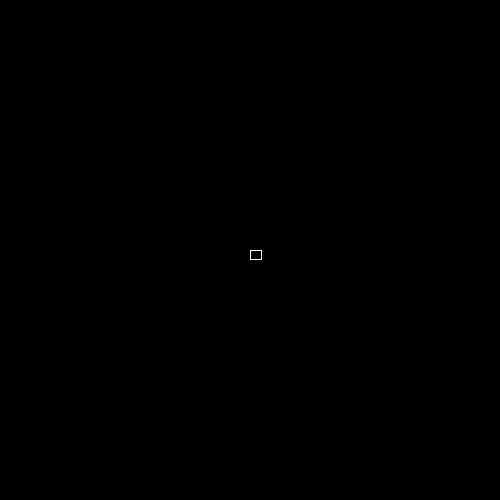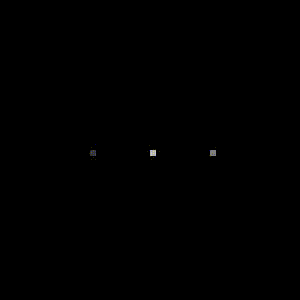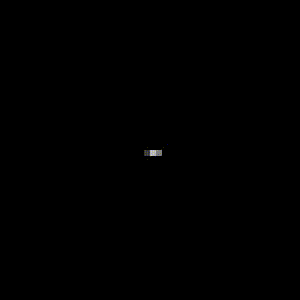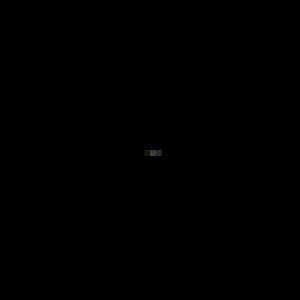Interesting examples of cellular automata
Interesting examples of cellular automata.
On Habré many articles on cellular automata ( http://habrahabr.ru/post/168291/ , http://habrahabr.ru/post/227003/ ), especially on the game "Life" ( http://habrahabr.ru/ post / 67790 / , http://habrahabr.ru/post/154509/ , http://habrahabr.ru/post/237629/ ). I want to tell something new - about other cellular automata, to give unexpected and interesting, in my opinion, examples. We look at the structure, which gradually copies its original configuration ; and on the structure that draws a circle .
Caution, big gifs
')
This also applies to definitions, but it will definitely come in handy:
 - the state of the structure.
- the state of the structure.
 - cell, then
- cell, then  - her condition. Something like: "according to the coordinates of the cell - its state".
- her condition. Something like: "according to the coordinates of the cell - its state".
 - new cell state
- new cell state
 - new state of the structure, where each cell has its own new state. (Applied
- new state of the structure, where each cell has its own new state. (Applied  to all cells)
to all cells)
Note that the new state of the structure does not depend on the “order of application” as it may seem at first glance: in fact, we do not change the state, we make a new field and fill it with new states.
as it may seem at first glance: in fact, we do not change the state, we make a new field and fill it with new states.
Configuration - the state of the structure with a finite number of non-zero cells.
We have some directions - surroundings. We want to
- surroundings. We want to  - XOR'ila all values from the neighborhood (including the value of the cell, the result of which is calculated). Why did we take that way? It's just clear to us that if we have only one single cell on the field, then in one move it will “copy out” into the entire neighborhood (inverted).
- XOR'ila all values from the neighborhood (including the value of the cell, the result of which is calculated). Why did we take that way? It's just clear to us that if we have only one single cell on the field, then in one move it will “copy out” into the entire neighborhood (inverted).
Obviously, the operation is linear (in the sense of XOR), that is, we can subtract the new configurations for each cell separately, and then element-wisely proximize the result, and not honestly read the new configuration. In other words (hereinafter under understood XOR): if
understood XOR): if  then
then  . Well, accordingly
. Well, accordingly  .
.
Denote - configuration with one unit in a cell
- configuration with one unit in a cell  element.
element.
Well, consider them separately. It is easy to see that the following configuration will have in cells
in cells  (including, 1 will remain in place), that is:
(including, 1 will remain in place), that is:

Let's see how the configuration will bring itself further (and then it will behave cool!):

It turns out that all members at they are reduced, for they include an even number of times in the sum (and we use the characteristic field two).
they are reduced, for they include an even number of times in the sum (and we use the characteristic field two).
Well, the proof base is ready to copy, try to make the transition. All the same, only instead of two - .
.
If application
 time looks like:
time looks like:

that

What I wanted to get.
Now we have
Cool, cool, our structure is really copied along the vectors that define the neighborhood.
Let's dig the sun:

On the example of a square, how it extends further:

A remarkable example of the incredible: with a discrete structure, with a finite memory of each cell (which means it cannot even remember its coordinates!), We will interpolate a continuous object — a circle — as much as you like.
I will not formally describe this system, since it will not become clearer from its formal description: there are a dozen states in the cell and the same number of elements in the surroundings.
Let's start. Almost obvious what a running signal is.

And it is clear that he can "push apart" the cells holding him.

This is almost all we need: let's launch a horizontal signal that will push the carrier cells, and with each pushing we will create two vertical latches and a vertical signal. It is clear that the signals can be arranged so that the horizontal does not conflict with the vertical ones: if they are superimposed, you need to make a new state that will “remember” in which directions the signals should be launched in the next step.
Why do fixing points tend to circle?
Denote:
 ,
,  - the distance "to the beginning" from the points fixing the horizontal signal;
- the distance "to the beginning" from the points fixing the horizontal signal;
 ,
,  - distance from the horizontal axis to the points fixing the vertical signal in the column with the index
- distance from the horizontal axis to the points fixing the vertical signal in the column with the index  ;
;
Then start time vertical signal:
vertical signal:  (for each
(for each  of the amount we need to move away from the center
of the amount we need to move away from the center  right, return, left, return), which is asymptotically
right, return, left, return), which is asymptotically  . Likewise, the time from the launch of a vertical signal to its height
. Likewise, the time from the launch of a vertical signal to its height  :
:  . Define
. Define  circle radius like
circle radius like  that is, we have
that is, we have  . As we already understood, the time of formation of a point on
. As we already understood, the time of formation of a point on  distance column
distance column  :
:  . This point lies on the circle of radius
. This point lies on the circle of radius  (Pythagorean theorem), that is
(Pythagorean theorem), that is  but
but  so we got that
so we got that  . And this means that all such (vertical fixing) points will be located approximately at the same distance from the center as the horizontal fixing points. Therefore, they will form a shape close to the circle.
. And this means that all such (vertical fixing) points will be located approximately at the same distance from the center as the horizontal fixing points. Therefore, they will form a shape close to the circle.
Beautiful picture, clarifying the situation:

Thanks to Arsen for the prototype sun!
On Habré many articles on cellular automata ( http://habrahabr.ru/post/168291/ , http://habrahabr.ru/post/227003/ ), especially on the game "Life" ( http://habrahabr.ru/ post / 67790 / , http://habrahabr.ru/post/154509/ , http://habrahabr.ru/post/237629/ ). I want to tell something new - about other cellular automata, to give unexpected and interesting, in my opinion, examples. We look at the structure, which gradually copies its original configuration ; and on the structure that draws a circle .
Caution, big gifs
')
Definition is an important thing, but not everyone is interested.
According to Kudryavtsev’s book, Introduction to Automata Theory, a cellular automaton (or a homogeneous structure) is a set:

Where the set of integer k-dimensional vectors is the cell structure. Will use
the set of integer k-dimensional vectors is the cell structure. Will use  ;
;
 - many states;
- many states;
 - an ordered set of pairwise different non-zero vectors from
- an ordered set of pairwise different non-zero vectors from  power
power  for convenience we put
for convenience we put  . This is a neighborhood of the cell;
. This is a neighborhood of the cell;
 - the function n of the valued logic h of arguments (
- the function n of the valued logic h of arguments (  ),
),  - rule of change of states;
- rule of change of states;
Generally speaking, instead of You can take and other media, just do it incredibly rarely. Why not make the cellular automaton on the torus?
You can take and other media, just do it incredibly rarely. Why not make the cellular automaton on the torus?
Where
Generally speaking, instead of
This also applies to definitions, but it will definitely come in handy:
Note that the new state of the structure does not depend on the “order of application”
Configuration - the state of the structure with a finite number of non-zero cells.
Copy structure
We have some directions
Obviously, the operation is linear (in the sense of XOR), that is, we can subtract the new configurations for each cell separately, and then element-wisely proximize the result, and not honestly read the new configuration. In other words (hereinafter under
Denote
Proof
Well, consider them separately. It is easy to see that the following configuration will have
Let's see how the configuration will bring itself further (and then it will behave cool!):
It turns out that all members at
Well, the proof base is ready to copy, try to make the transition. All the same, only instead of two -
If application
that
What I wanted to get.
Now we have
Cool, cool, our structure is really copied along the vectors that define the neighborhood.
Let's dig the sun:

On the example of a square, how it extends further:

Circle
A remarkable example of the incredible: with a discrete structure, with a finite memory of each cell (which means it cannot even remember its coordinates!), We will interpolate a continuous object — a circle — as much as you like.
I will not formally describe this system, since it will not become clearer from its formal description: there are a dozen states in the cell and the same number of elements in the surroundings.
Let's start. Almost obvious what a running signal is.
How does
There are two cells with fixed states and one “signal” - a cell in the segment between the first two. A sign has two states: “move to the left” and “move to the right,” and, unexpectedly, in these states it evolves in a certain direction. In contact with fixed cells, he turns in the opposite direction.

And it is clear that he can "push apart" the cells holding him.
How does
Each of the fixed cells in contact with the signal will behave similarly to the signal: move to the side.

This is almost all we need: let's launch a horizontal signal that will push the carrier cells, and with each pushing we will create two vertical latches and a vertical signal. It is clear that the signals can be arranged so that the horizontal does not conflict with the vertical ones: if they are superimposed, you need to make a new state that will “remember” in which directions the signals should be launched in the next step.
Why do fixing points tend to circle?
Denote:
Then start time
Beautiful picture, clarifying the situation:

Thanks to Arsen for the prototype sun!
Source: https://habr.com/ru/post/267219/
All Articles